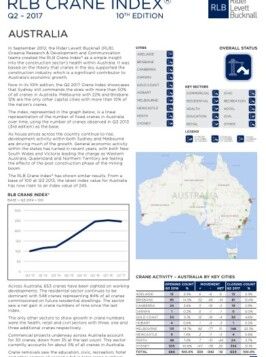Rider Levett Bucknall’s Q2 2017 RLB Crane Index® released today highlights that the Sydney and Melbourne construction markets continue growing, while the rest of Australia’s key construction markets have not recorded any growth since our last publication in Q3 2016.
Now in its 10th edition, the bi-annual RLB Crane Index® was created by the firm’s Oceania Research & Development and Communication teams as a simple indicator of building activity, and the general health of our construction markets.
Stephen Ballesty, the Rider Levett Bucknall (RLB) Director of Research & Development commented, ‘As residential prices across the country continue to rise, development activity across both Sydney and Melbourne are fuelling much of the national growth numbers.’
Other states feeling the post-construction phase of mining boom
‘General economic activity across the states has turned in recent years, with both New South Wales and Victoria leading the charge as Western Australia, Queensland and Northern Territory are feeling the effects of the post construction phase of the mining boom,’ he said.
This index has identified 654 cranes in total across Australia, down 12 from a peak of 666 in October 2016. 330 new tower cranes were erected in the past six months, offset by the removal of 342 from projects nearing completion, highlighting very strong levels of activity over the short term.
First fall recorded in five years
Stephen continued, ‘Interestingly, this slight decrease in the total number of cranes is the first fall recorded since the firm’s inaugural report nearly five years ago.’
He added, ‘What we are seeing is a drop in cranes overall caused by the completion of a number of ‘super’ projects – the Gold Coast’s Commonwealth Games Village (6) and Perth Stadium (7) – but a rise in the number of sites with cranes.
Sydney still the hottest construction market
The Q2 2017 RLB Crane Index® continues to highlight the strength of the construction industry. With 50% of the nation’s cranes, up from 46% at our last index, activity is most buoyant in Sydney (334) and Melbourne (146). These markets are followed by Brisbane (81), Perth (24), Gold Coast (30), Canberra (19), Adelaide (15), Newcastle (4), and Darwin (0). Hobart has one crane.
Perth recorded the largest decline in the number of cranes during this period with a reduction of 24, due to the completion of 16 projects. Brisbane followed with a fall of 14 and then Canberra down by five.
Residential sector dominates
The residential sector continues to dominate with 548 cranes (84% of all cranes commissioned on future dwellings). This sector shows a net gain of nine since the last index. Other sectors to show growth are the health, retail and civil sectors with three, one and three additional cranes respectively.
According to the RLB Crane Index®, commercial projects across Australia account for 30 cranes, down from 35. This sector currently accounts for about 5% of all cranes in Australia.
Sydney drives crane activity but Melbourne leads education and retail sectors
Sydney has the greatest number of cranes erected in the residential (292), commercial (13), civil (7) and civic (6) sectors. The spread of cranes, highlighted in the heat maps within this edition, showcase the construction activity along the main northern, western and southern corridors of Sydney.
Melbourne dominated the education sector (4) and retail sector (2). Construction work done in Victoria was up 6% in 2016. Residential work is still strong, recording a 10% lift while non-residential work was down 8%.
Cranes across Melbourne now number 146, up from 131 in the previous edition, a net gain of 15 cranes. 92 cranes were added and 77 removed from sites.
Adelaide had the strongest health retail sector (7 cranes), and Perth stood out having 4 cranes erected on hotel projects.
About the RLB Crane Index® hotspots maps
Hotspots maps offer a pictorial representation of the collected data for each city using a heat map indicator to indicate the level of crane activity.
The size of hotspot is relative to the scale of the map and is not an indication of the crane count in that position. The map uses blue to indicate a lower crane activity, and the brighter red insert to indicate higher crane activity.
The location of the hotspots is indicative only and have been positioned to convey the general spread of cranes within a city. The levels of intensity are calculated on a map by map basis and should not be compared between different cities.
FURTHER INFORMATION:



